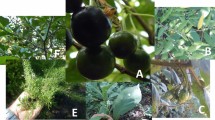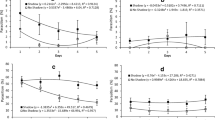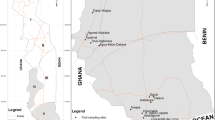Abstract
A total of 1,302 parasitoids representing 8 species and 4 families were recovered from 9,818 fruit fly host fruits sampled. The most common parasitoid species wasDiachasmimorpha longicaudata (Ashmead). Average percent parasitism ranged between 0.44 and 29.23%. Parasitoid emergence data indicate thatAnastrepha ludens (Loew),A. obliqua (Sein),A. serpentina (Wiedeman),A. striata (Schiner) andToxotrypana curvicauda (Gerstaecker) were subject to parasitism. We provide information on the population fluctuation ofAnastrepha ludens, A. obliqua, A. serpentina, A. distincta (Greene),A. striata, A. fraterculus (Wiedeman),A. chiclayae (Greene),A. montei (Costa Lima),A. leptozona (Hendel) andA. tripunctata (Wulp).Anastrepha ludens andA. obliqua were the most common species, representing 95.3% of all fruit fly species caught in McPhail traps.
Resumen
De 9 818 frutas hospederas de las moscas de la fruta que se muestrearon, emergieron un total de 1 302 parasitoides (8 especies y 4 familias). El parasitoide más común fueDiachasmimorpha longicaudata (Ashmead). El porcentaje promedio de parasitismo fluctuó entre 0.44 y 29.23%. Cinco especies de moscas de la fruta resultaron parasitadas:Anastrepha ludens (Loew),A. obliqua (Sein),A. serpentina (Wiedemanà,A. striata (Schiner) yToxotrypana curvicauda (Gerstaecker). Se describe la fluctuación de las poblaciones deAnastrepha ludens, A. obliqua, A. serpentina, A. distincta, A. striata, A. fraterculus (Wiedeman),A. chiclayae (Greene),A. montei (Costa Lima),A. leptozona (Hendel) yA. tripunctata (Wulp).Anastrepha ludens yA. obliqua fueron las especies más comunes, representando el 95.3% del total de especies de moscas de la fruta capturadas en trampas McPhail.
Résumé
Des 9 818 échantillons de fruits attaqués par les Mouches, il a été récolté 1 302 parasitoïdes représentant 8 espèces et 4 familles. L'espèce parasite la plus fréquente étaitDiachasmimorpha longicaudata (Ashmead). Le pourcentage moyen de parasitisme était compris entre 0,44 et 29,23%. Les données relatives à l'émergence des parasitoïdes indiquaient queAnastrepha ludens (Loew),A. obliqua (Sein),A. serpentina (Wiedeman),A. striata (Schiner) etToxotrypana curvicauda (Gerstaecker) étaient soumises au parasitisme. Il est fourni des informations sur les fluctuations de populations d'Anastrepha ludens, A. obliqua, A. serpentina, A. distincta (Greene),A. striata, A. fraterculus (Wiedeman),A. chiclayae (Greene),A. montei (Costa Lima),A. leptozona (Hendel) etA. tripunctata (Wulp.).Anastrepha ludens etA. obliqua furent les espèces les plus communes, représentant à elles seules 95,3% de l'ensemble des espèces de mouches capturées au piègeMcPhail.
Similar content being viewed by others
References
Aluja, M. — 1985. Manejo integrado de las moscas de la fruta [Diptera: Tephritidae]. —Programa Mosca Med, DGSV-SARH, Mexico, 241 pp.
Aluja, M. &Liedo, P. — 1986. Future perspectives on integrated management of fruit flies in Mexico. In: Pest Control: operations and systems analysis in fruit fly management (M. Mangel, ed.). —Springer, New York, 12–48 pp.
Aluja, M., Cabrera, M., Rios, E., Guillen, J., Celedonio, H., Hendrichs, J. &Ledo, P. — 1987a. A survey of the economically important fruit flies [Diptera: Tephritidae] present in Chiapas and a few other fruit growing regions in Mexico. —Fl. Entomol., 70, 320–329.
Aluja, M., Guillen, J., de la Rosa, G., Cabrera, M., Celedonio, H., Liedo, P. &Hendrichs, J. — 1987b. Natural host plant survey of the economically important fruit flies [Diptera: Tephritidae] of Chiapas, Mexico. —Fl. Entomol., 70, 329–338.
Baker, A. C., Stone, W. E., Plummer, C. C. & McPhail, M. — 1944. A review of studies on the Mexican fruitfly and related Mexican species. —USDA Misc. Publ., No. 531, Washington, USA.
Bravo-Mojica, H. — 1959. Parasitismo en larvas de diferentes edades y mejor relación parasito huesped deSyntomosphyrum indicum Silv., un enemigo natural de moscas de la fruta. —Unpubl. B.S. thesis, Escuela Nacional de Agricultura, Chapingo, México, 29 pp.
Clausen, C. P. — 1978. Introduced parasites and predators of arthropod pests and weeds: a world review. —USDA Agric. Handbook, No. 480, Washington, 545 pp.
Gingrich, R. E. — 1987. Demonstration ofBacillus thuringiensis as a potential control agent for the adult Mediterranean fruit fly,Ceratitis capitata (Wied.). —J. Appl. Entomol., 104, 378–385.
Gonzalez-Hernandez, A. &Tejada, L. O. — 1979. Fluctuación de la población deAnastrepha ludens (Loew) y de sus enemigos naturales enSargentia greggii S. Watts. —Folia Entomol. Mexicana, 41, 49–60.
Herrera, A. L. — 1905. El gusano de la naranja. —Bol. Com. Parasitol. Agríc. (Mexico), Tomo II, 307–415.
Houston, W. W. K. — 1981. Fluctuations in numbers and the significance of the sex ratio of the Mexican fruit fly,Anastrepha ludens caught in McPhail traps. —Entomol. Exp. & Appl., 30, 140–150.
Jimenez-Jimenez, E. — 1956. Las moscas de la fruta y sus enemigos naturales. —Fitófilo (México), 9, 4–11.
Jimenez-Jimenez, E. — 1961. Resumen de los trabajos de control biológico que se efectuan en México para el combate de plagas agrícolas. —Fitófilo (México), 14, 9–15.
Landeros, J. F. — 1978. Evaluación de algunos factores reguladores de la población deAnastrepha ludens (Loew) en su hospedera silvestreSargentia greggii Watts, en la región de Rincón de la Sierra, Guadalupe, Nuevo León, México. —Unpubl. B.S. thesis, ITESM, 53 pp.
Lindergren, J. E. &Vail, P. V. — 1986. Susceptibility of Mediterranean fruit fly, melon fly and oriental fruit fly [Diptera: Tephritidae] to the entomogenous nematodeSteinernema feltiae in laboratory tests. —Environ. Entomol., 15, 465–468.
Knipling, E. F. — 1986. The estimated relative effects ofBiosteres oophilus andB. longicaudatus releases on rates of parasitism and on the dynamics ofDacus dorsalis populations in Hawaii. —USDA Working Paper, USDA-ARS.
Ortiz, H. J. J. — 1958. Observaciones sobre la biología de la mosca de la frutaAnastrepha ludens y sus enemigos naturales en la zon cítrica de Rio Ramos, Nuevo León, México y sus alrededores. —Unpubl. B.S. thesis, Univ. de Nuevo Leon.
Ruiz-Cancino, E. — 1979. Parasitismo natural enAnastrepha ludens (Loew) en hospederas silvestres y cultivadas en zona centro de Tamaulipas, México. —Unpubl. Seminario de Investigación II, Univ. Autónoma de Tamaulipas, Nov. 1979, 20 pp.
San Juana, S. — 1974. Control biológico de las moscas de la fruta en el Cañon del Tomellín, Oaxaca, México. —Dir. Gen. Sanidad Vegetal, SARH.
Van Driesche, R. G. — 1983. Meaning of “percent parasitism” in studies of insect parasitoids. —Environ. Entomol., 12, 1611–1622.
Wharton, R. A., Gilstrap, F. E., Rhode, R. H., Fischel-M., M. &Hart, W. G. —1981. Hymenopterous egg-pupal and larval-pupal parasitoids ofCeratitis capitata andAnastrepha spp. [Diptera: Tephritidae] in Costa Rica. —Entomophaga, 26, 285–290.
Wong, T. Y., McInnis, D. O., Nishimoto, J. I., Ota, A. K. &Chang, V. C. S. —1984. Predation of the Mediterranean fruit fly [Diptera: Tephritidae] by the Argentine Ant [Hymenoptera: Formicidae] in Hawaii. —J. Econ. Entomol., 77, 1454–1458.
Author information
Authors and Affiliations
Rights and permissions
About this article
Cite this article
Aluja, M., Guillen, J., Liedo, P. et al. Fruit infesting tephritids [Dipt.: Tephritidae] and associated parasitoids in Chiapas, Mexico. Entomophaga 35, 39–48 (1990). https://doi.org/10.1007/BF02374299
Received:
Accepted:
Issue Date:
DOI: https://doi.org/10.1007/BF02374299




